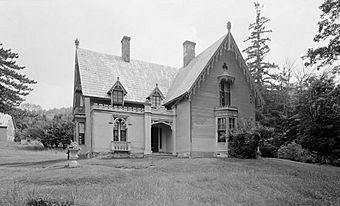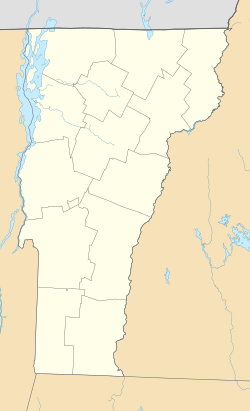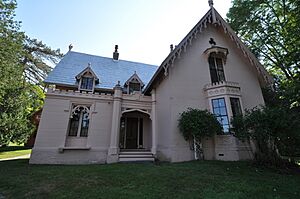Justin Smith Morrill Homestead facts for kids
|
Justin S. Morrill Homestead
|
|
|
U.S. Historic district
Contributing property |
|

The Justin Smith Morrill House, a historic home in Vermont.
|
|
| Location | Strafford, Vermont |
|---|---|
| Area | 3 acres (1.2 ha) |
| Built | 1855 |
| Architect | Justin Smith Morrill |
| Architectural style | Carpenter Gothic |
| Part of | Strafford Village Historic District (ID74000246) |
| NRHP reference No. | 66000795 |
Quick facts for kids Significant dates |
|
| Added to NRHP | October 15, 1966 |
| Designated NHL | September 22, 1960 |
| Designated CP | June 20, 1974 |
The Justin Smith Morrill Homestead is the historic home of U.S. Senator Justin Smith Morrill. Located in Strafford, Vermont, this house is famous for its unique Carpenter Gothic style. It was one of the first places in the United States to be named a National Historic Landmark in 1960.
Today, the homestead is a Vermont State Historic Site. This means it is protected by the state government. Visitors can take tours of the house and grounds from May through October each year.
Contents
A Look at the Homestead
The Morrill Homestead sits on a 3-acre piece of land near the center of Strafford Village. Besides the main house, the property has several barns and sheds. A special reddish-colored fence with granite posts separates the property from the road.
The House's Unique Design
The main house is a one-and-a-half-story wooden building with a steeply sloped slate roof. It has a fancy, decorative style known as Gothic Revival. This style includes special wood carvings and pointed arches, making it look a bit like a small castle.
Inside, the house has detailed woodwork made from mahogany. Most rooms match the Gothic style of the outside. However, the main living room has a simpler, more classic Greek Revival look. Many of the original items owned by the Morrill family are still in the house, from furniture to kitchen tools.
Building a Family Home
Justin Morrill designed the house himself and watched over its construction between 1848 and 1851. The year it was finished, 1851, was also the year he married Ruth Barrell Swan. They had two children together.
Because Morrill was a senator, he spent a lot of time in Washington, D.C.. The family mainly used the house in Vermont as a summer home. After Morrill passed away in 1898, the house stayed in his family for many years. It was sold during World War II and was later bought by people who wanted to protect it. In 1969, they sold it to the state of Vermont so it could be preserved for everyone to enjoy.
Who Was Justin Morrill?
Justin Morrill was an important politician who served in the U.S. Congress for a very long time. His work had a big impact on the entire country, especially in the field of education.
Creating Colleges for Everyone
Morrill's most famous achievement is the Morrill Land-Grant Acts. These were two laws, passed in 1862 and 1890, that changed American education forever.
The laws gave federal land and money to states. The states used these gifts to build universities, which became known as land-grant universities. These schools made it possible for many more people, including those from farming and working-class families, to get a college education. Many of today's major state universities were started because of these acts.
Other Important Projects
During his career, Morrill also helped with other major national projects. He played a key role in:
- Finishing the Washington Monument.
- Building the Library of Congress.
- Designing the beautiful gardens and grounds around the United States Capitol Building.
See also




